2024 April 3
Observer’s Challenge – view a partial solar eclipse on April 8

WARNING – OBSERVING THE SUN CAN BE DANGEROUS – READ OUR GUIDE BELOW
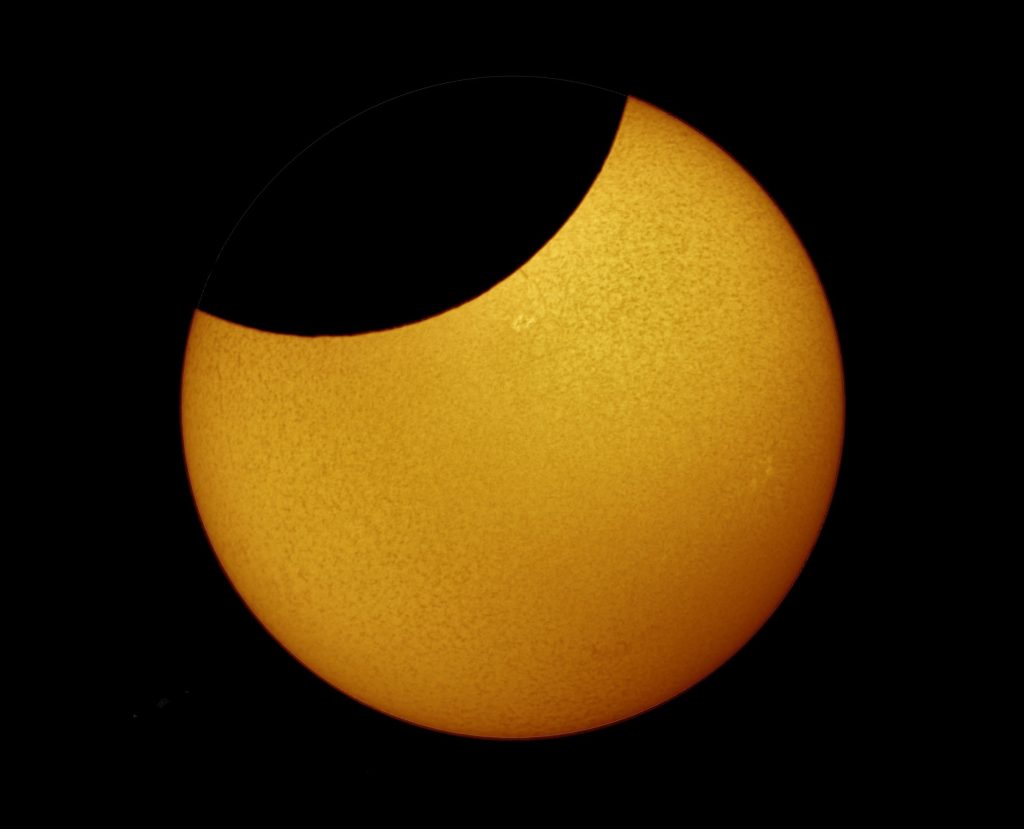
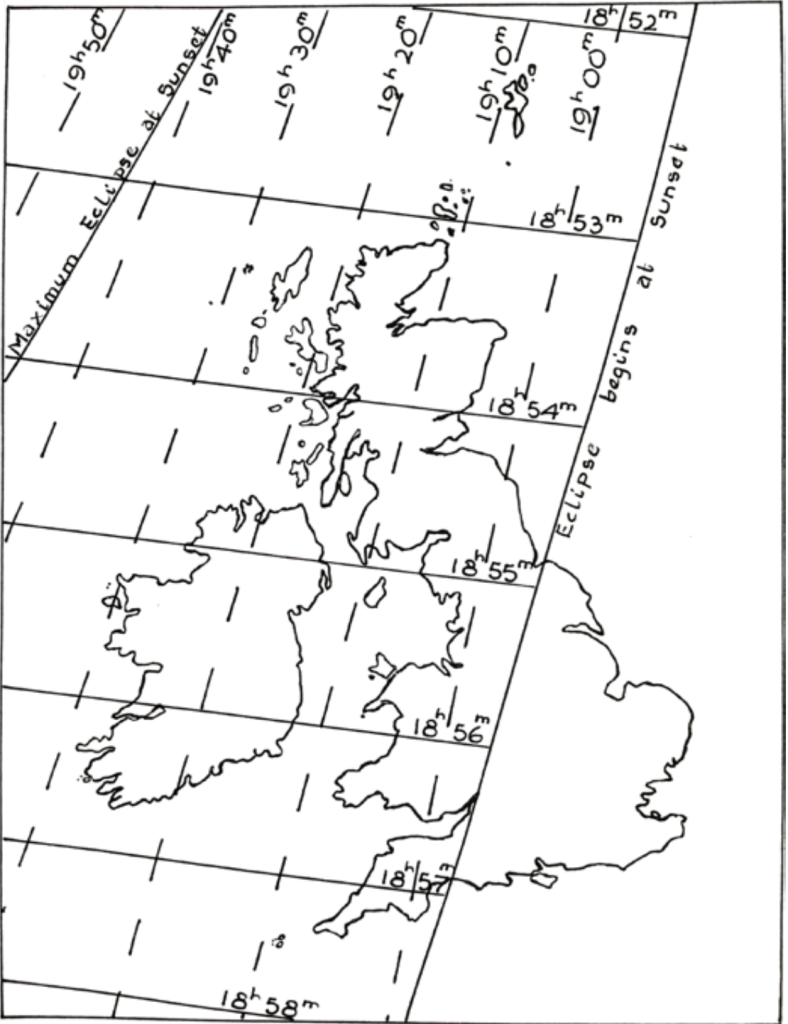
While some are travelling to central and north America to see the Total Eclipse of the Sun, those remaining in the UK may be able to see a Partial Eclipse.
This will be a challenge, as the eclipse will start not long before sunset, and a clear western horizon will be needed. ‘Wester is bester’ is the motto for this challenge, and for parts of the UK in the east, midlands and central southern counties no eclipse will be visible. Western Scotland and Ireland will have the longest eclipse period.
Details were published in the Journal of the British Astronomical Association, February 2024 in an Observers Forum article by Peter Macdonald.
This map shows the extent of the visible eclipse over the UK and Ireland. No eclipse will be visible to the east of the right line where the eclipse starts at sunset.
Here are some local circumstances in UT – add one hour for BST.
| First Contact UT | Sun Alt | Sun Az | Sunset | |
| Armagh | 18:55 | 2.3° | 280° | 19:17 |
| Edinburgh | 18:54 | 0.8° | 282° | 19:06 |
| Lerwick | 18:53 | 0.9° | 284° | 19:07 |
| Stornoway | 18:53 | 3.0° | 280° | 19:23 |
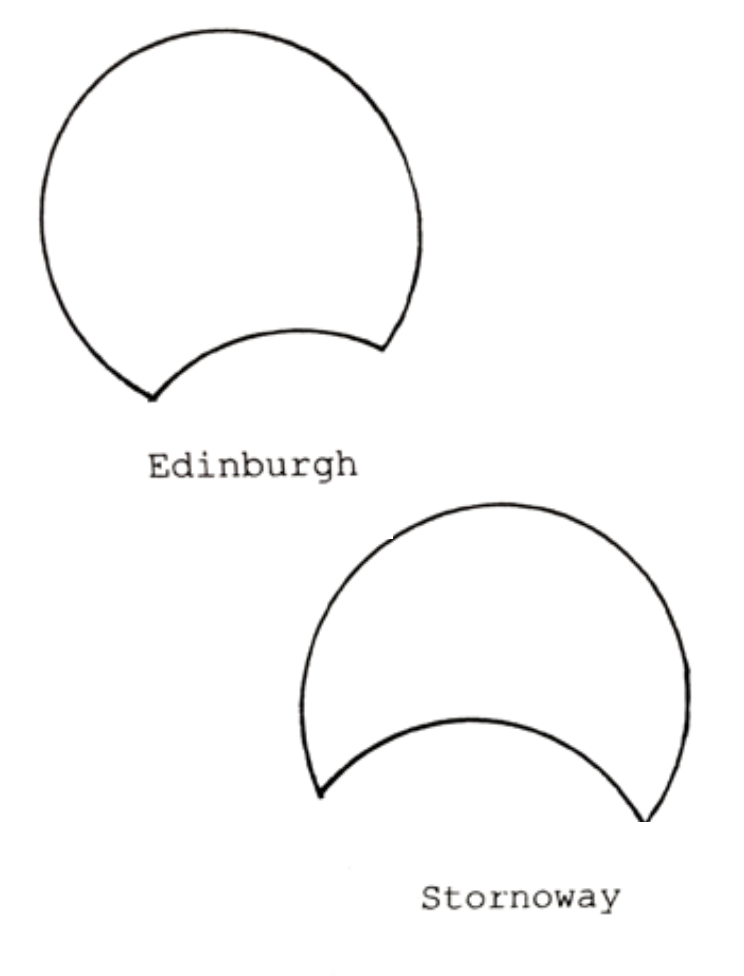
Post your images to your Members Album and you can check back here to see a gallery of images after the event..
But remember that viewing the Sun can be dangerous, so please read our solar eclipse viewing guide below for instructions on how to do this safely.
Solar Eclipse Observing Guide
It is extremely dangerous to just go out and look up. The Sun is so bright that just looking at it can result in serious eye damage or blindness. The danger is NOT because of the eclipse – it is dangerous to look at the Sun at any time. So you’ll need to prepare beforehand. There are various ways to observe the eclipse safely, using both everyday materials and telescopes or binoculars. This guide tells you what will happen and how you can safely view all the stages of the event.
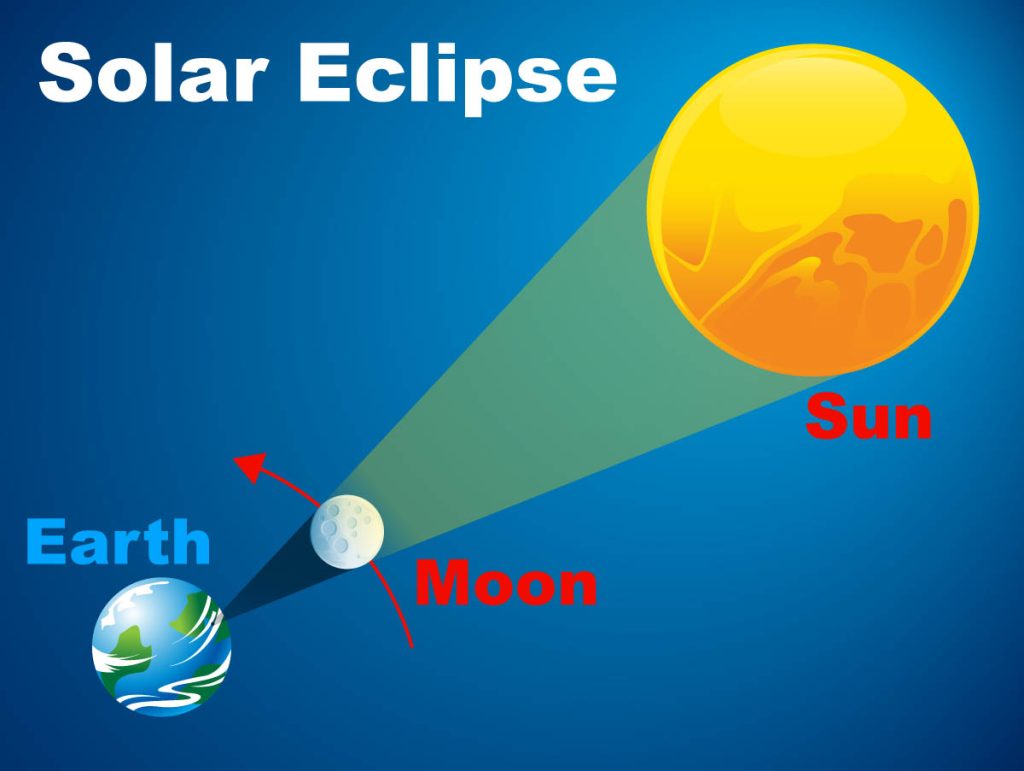
What will happen
A solar eclipse occurs when the Moon comes directly between the Sun and the Earth.
Note that this eclipse won’t be as spectacular as a total solar eclipse where the Sun is completely covered by the Moon, the sky goes dark and one can see streamers in the Sun’s outer atmosphere, the corona, extending outwards from the Moon’s dark silhouette
From the UK, the Earth, Moon and Sun are less precisely aligned. This means that the Moon appears to only take a fairly small bite out of the edge of the Sun’s disc. The eclipse will take place over a couple of hours, with mid-eclipse occurring just before 11 am BST. It’s not as spectacular as a total eclipse, but If you take the proper precautions it’s a great thing to watch, and something you’ll remember for many years to come.
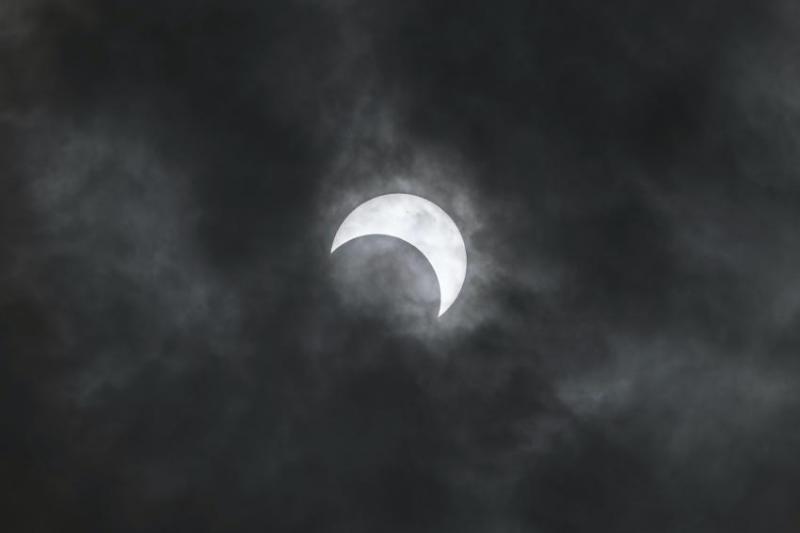
The partial phase of the annular eclipse of 20 May 2012.
Credit – Photo by Marek Okon on Unsplash
How to observe
Viewing a solar eclipse is potentially hazardous and should only be attempted with caution. The Sun is the brightest object in the sky. In addition to the visible light, it sends out huge amounts of invisible infrared and ultraviolet rays which can harm your sight. You should never, ever – under any circumstances – look directly at the Sun without proper eye protection!
DON’T ever look at the uneclipsed, partially-eclipsed or annularly-eclipsed Sun through an unfiltered camera, telescope, binoculars or other optical instrument.
Suitable filters have to be so dense that you can’t normally see through them.
DON’T try black plastic such as bin liners, no matter how thick. They may look dense, but they transmit infrared (heat) radiation, which can seriously damage your eyesight even though the Sun might look dim.
DON’T view the Sun through sunglasses of any type (single or multiple pairs, no matter how dark), or filters made of black & white or colour photographic film, or any combination of photographic filters, crossed polarisers or gelatin filters, CDs, CD-ROMs, or smoked glass. These are NOT safe.
DO view the Sun ONLY through special-purpose solar filters, such as so-called “eclipse glasses” or handheld solar viewers, made for safe solar viewing, e.g. aluminised mylar filters, or black polymer filters, identified as suitable for direct viewing of the Sun. If you purchased these filters a few years ago, perhaps before the partial solar eclipse visible from the British Isles in March 2015, these will bear the CE mark AND a statement that it conforms to European Community Directive 89/686/EEC. However, the international standard for filters that are suitable for direct viewing of the Sun is now ISO 12312-2, which supersedes CE and other standards, that were regional not global. All modern eclipse glasses or viewers should carry a statement that they are compliant with the ISO 12312-2 standard and should only be obtained from a reputable supplier. You could also use a welder’s glass rated at No. 14 or higher. Always read and follow the manufacturer’s instructions carefully.
DO check filters thoroughly for any damage BEFORE use. DON’T use them if they are wrinkled, scuffed, scratched or there are pinholes in them.
DO place the special filter firmly over your eyes BEFORE looking up at the Sun, and DON’T remove it until AFTER looking away.
DO use the special filters to view the eclipse while any part of the Sun’s brilliant disk, however small, is still visible. This will apply at ALL times when you are viewing an annular or partial eclipse as on 10 June. Intermittent use of the filter for the duration of the partial eclipse is the best way to view the event.
DO supervise children closely at all times when using solar filters.
Even with the special filter placed firmly over your eyes, DON’T ever look at the Sun through any optical instrument, e.g. telescope, binoculars or camera. Such devices concentrate the Sun’s harmful radiation and will cause severe eye damage in a fraction of a second. Filters identified as suitable for direct viewing of the Sun are NOT safe for use in conjunction with any optical instrument.
If you are not certain that a filter is approved and safe, or you have any other doubts, DON’T USE IT.
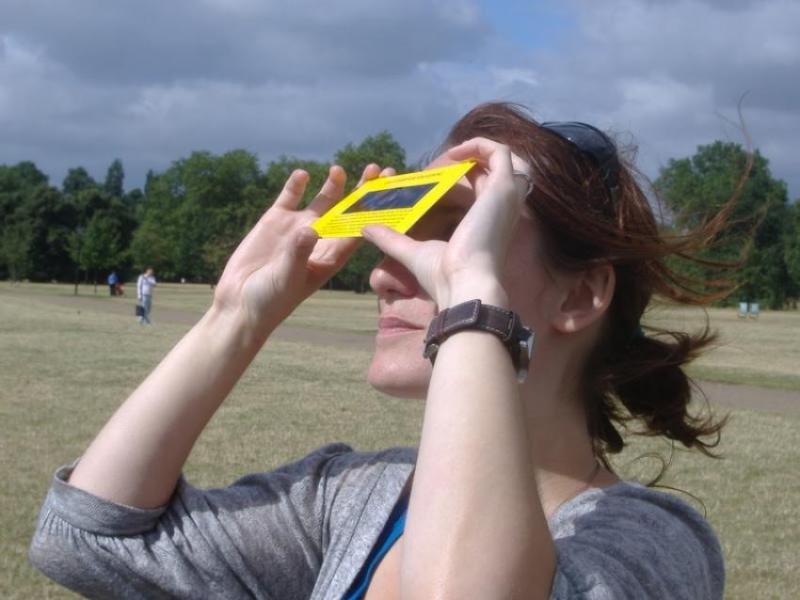
A woman using eclipse shades, certified to safety standards, to view a solar eclipse.
Credit – Robin Scagell – All Rights Reserved
Mirror projection
If you don’t have any “eclipse glasses” or handheld solar viewers, made for safe solar viewing, there is a good way to view the progress of the eclipse using nothing more elaborate than a small mirror. A compact or small shaving mirror is ideal, particularly if it has a stand to hold it in position. Use the flat side, not the concave or magnifying side.
All you need to do is to cover the mirror with paper in which you have cut a hole about 4 mm or an eighth of an inch across. The hole doesn’t have to be neat, or even round. Then shine the Sun’s reflection from the mirror into a room or onto any surface that’s in shade. You’ll see a circular spot of light which is in fact an image of the Sun. A projection distance of about 5 metres (15 feet) works perfectly, giving an image about 50 mm (2 inches) across, and you can view the image on a wall or a white piece of paper or whatever you have to hand.
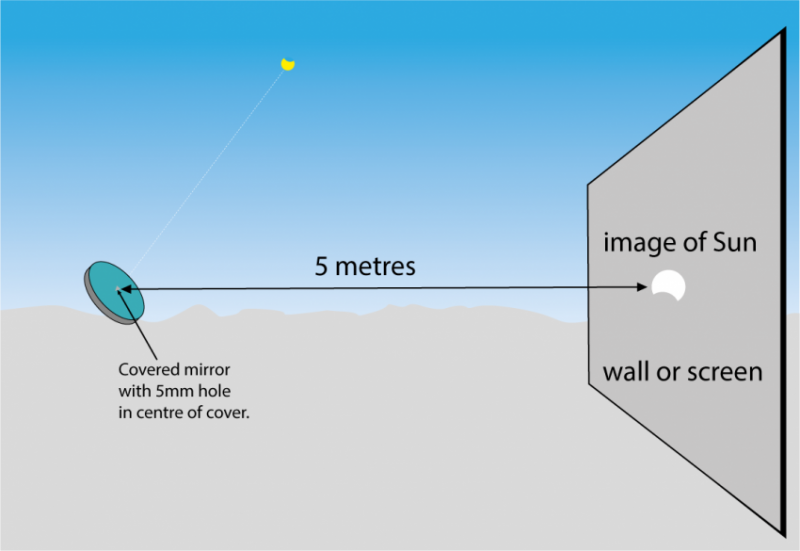
Use a covered mirror with a 5mm hole in the cover to reflect the image of the eclipse onto a wall. Never look directly at the Sun.
Credit – RAS/Lucinda Offer
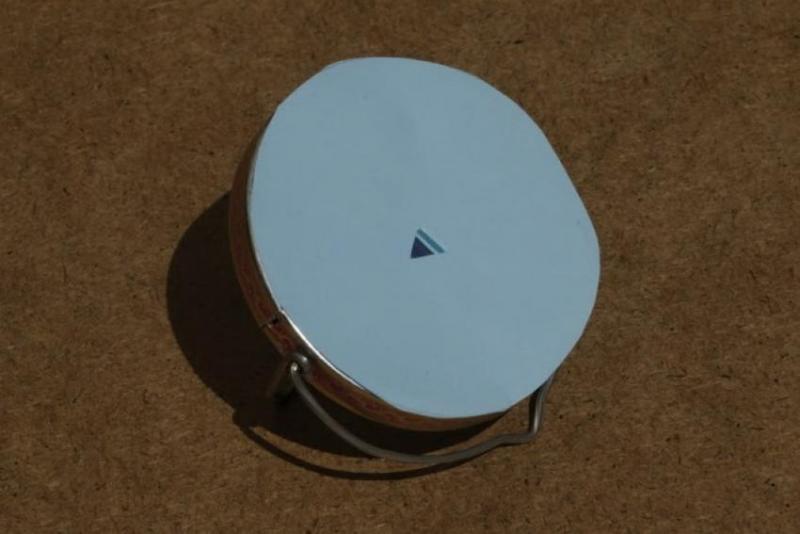
Cover the mirror with paper and create a 4-5mm hole in the centre of the cover.
Credit – Robin Scagell – All Rights Reserved
As the eclipse progresses you’ll see in perfect safety the Moon progressively taking a bite out of the edge of the Sun. It will be a little fuzzy around the edges, but it will be obvious to see.
Other simple methods of projection, such as using a pinhole in the side of a cereal packet, are possible but the image size is very small – only about 1 mm. So the fairly small bite from the Sun in the partial eclipse of 10 June as seen from the UK will hardly be visible.
Projection using binoculars or telescope
You can use a small telescope or binoculars with great care to project the Sun’s image for a very sharp view. Without looking through it, point the instrument at the Sun, judging from its shadow when it is in line. Hold a sheet of white paper about 30 cm (12 inches) away and you should see a bright spot appear when everything is lined up. You will probably need to focus to get a sharp image.
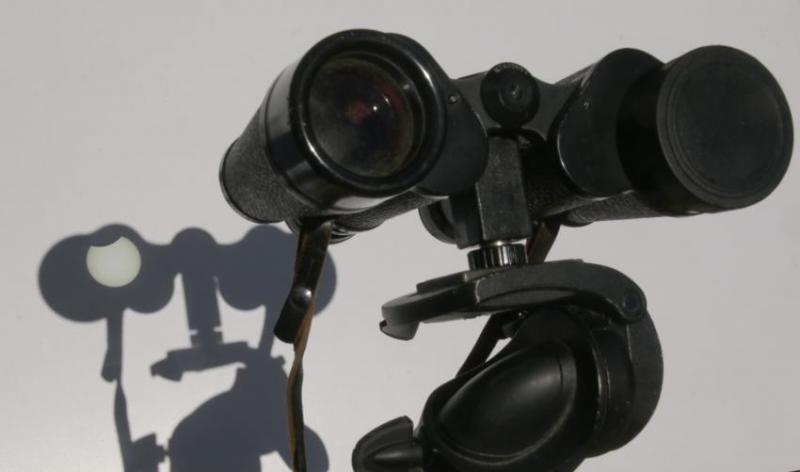
An image of the Sun projected using binoculars to simulate the view of the 10 June partial solar eclipse from the UK.
Credit Robin Scagell – All Rights Reserved
If you use a tripod make sure that there’s no chance that someone can accidentally look into the eyepiece of the instrument, This is the main danger with this method. The lesser danger is ruining the interior of the eyepiece. If the Sun’s bright image moves out of the field of view it will be focused on the interior of the eyepiece, which these days is often made of plastic even if the barrel is metal. The result will be very obvious damage to the field stop, which is what gives you the well-defined circle when you view a scene. You have been warned!
If you have a telescope and are projecting the image, or are viewing it using a safe solar filter, you may notice that there are dark spots on the Sun: sunspots. These are regions where relatively cool gas, that doesn’t glow as brightly as the hotter gas around it, is trapped by strong magnetic fields. Although sunspots look black, they are still part of the Sun and if the Moon’s disc happens to cross one you could notice that the Moon’s disc is darker than the sunspot. At the moment the Sun is not very active, but there are usually small spots visible.
Also look at the edge of the Moon (known as the limb) and you might see that it isn’t completely smooth, as you can see mountains or valleys on the limb silhouetted against the Sun. You’ll also probably see a lot of shimmering at the limb, which is caused by turbulence in our own atmosphere rather than anything astronomical.
Resources
For teacher resources or to learn more about eclipses, please take a look at these links:
• Role play a solar eclipse: Years 2 -5
• Solar Eclipse Worksheet: Years 7-9
• The Mathematics of a Total Solar Eclipse: Years 10-11
• Solar Eclipse News Article
The British Astronomical Association (BAA)would like to thank the Royal Astronomical Society (RAS) and the Society for Popular Astronomy (SPA) for their valuable collaboration on this article.
| The British Astronomical Association supports amateur astronomers around the UK and the rest of the world. Find out more about the BAA or join us. |
